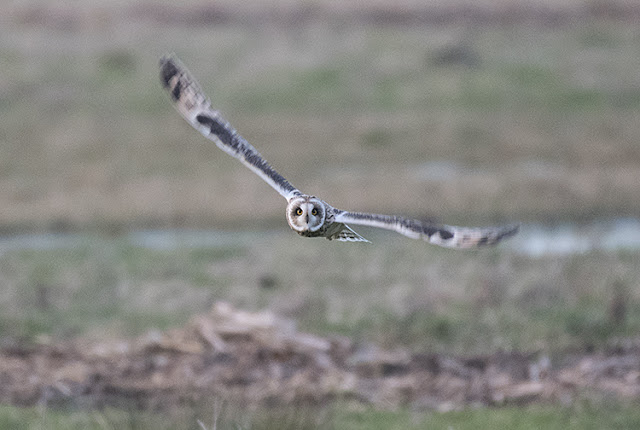After last Friday's amazing afternoon watching Short-eared Owls on the Nene Washes in Cambridgeshire, I was itching to go back for another go and with the sun shining today, I was able to take the afternoon off for a return visit. Despite it being midweek, when I arrived shortly after 2.30pm, the car park was already full and the bridge crammed with birders and photographers, but already at least 2 Short-eared Owls were out hunting, and a Red Kite passed overhead, though I wasn't quite prepared to get any decent shots before it drifted off.
Over the next 90 minutes, at least 5 Short-eared Owls quartered over the grassland, coming much closer than they did on Friday, and being out earlier the light was so much better.
Thursday, 25 January 2018
Saturday, 20 January 2018
An afternoon with owls
Any day you see an owl is a good one! They have to be my favourite bird family, and having seen on RSPB in the Fens Twitter feed about some Short-eared Owls showing regularly by the Eldernell car park on the Nene Washes in Cambridgeshire, I couldn't resist a visit. Thankfully being more diurnal than most owls, Short-eareds can be seen at all times of the day, though late afternoon is usually the best time to watch them as they ghost across rough grassland and pounce on unsuspecting rodents in the grass.
Arriving at the car park at just after 2pm, there were already several photographers waiting on the bridge for the owls to show. Distant Whooper and Bewick's Swans, a couple of Marsh Harriers and a group of Roe Deer kept us occupied but the wait continued. It was nearly 3.30pm when the first owl appeared, distantly at first but then came closer and was joined by at least two others, occasionally coming fairly close but most times keeping their distance. Photographing them in flight was a challenge with the light fading all the time while still trying to get used to the autofocus options on my new camera produced a mix of results.
Just as we were about to leave, a Barn Owl began hunting by the car park, but the light really had gone for photography by that point.
Arriving at the car park at just after 2pm, there were already several photographers waiting on the bridge for the owls to show. Distant Whooper and Bewick's Swans, a couple of Marsh Harriers and a group of Roe Deer kept us occupied but the wait continued. It was nearly 3.30pm when the first owl appeared, distantly at first but then came closer and was joined by at least two others, occasionally coming fairly close but most times keeping their distance. Photographing them in flight was a challenge with the light fading all the time while still trying to get used to the autofocus options on my new camera produced a mix of results.
Just as we were about to leave, a Barn Owl began hunting by the car park, but the light really had gone for photography by that point.
Monday, 8 January 2018
More local Otters
Having just treated myself to a new camera, it was only right to get out and try it out on some more local Otters. Although the Thetford ones from a few years ago are now only seen occasionally, there have recently been a up to 4 along the river at Santon Downham which are becoming well known and very popular with photographers. Toni and I spent a couple of hours with one of the Otters, though as always seems to be the case whenever I photograph Otters, they show best when the light isn't that great, and even on sunny days, will invariably show best in the shadiest stretches of the river. They also seem to have a fondness for hunting around fallen trees and so getting shots without branches covering the face can be tricky but can usually be got with a bit of patience. I'll no doubt be back to see these animals a lot more times this year, especially as this stretch of river is one I survey for the Waterways Breeding Bird Survey, but for a first visit, this particular Otter performed well for the small appreciative crowd.
There were also many Little Grebes along the river here, and unusually for this species, were remarkably photogenic.
There were also many Little Grebes along the river here, and unusually for this species, were remarkably photogenic.
Subscribe to:
Comments (Atom)
















